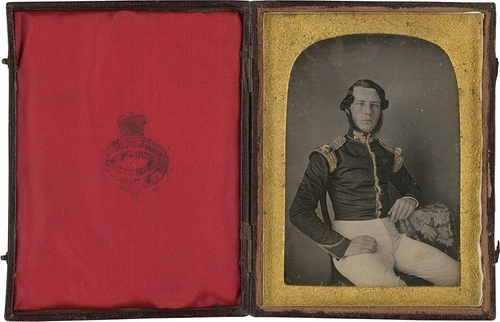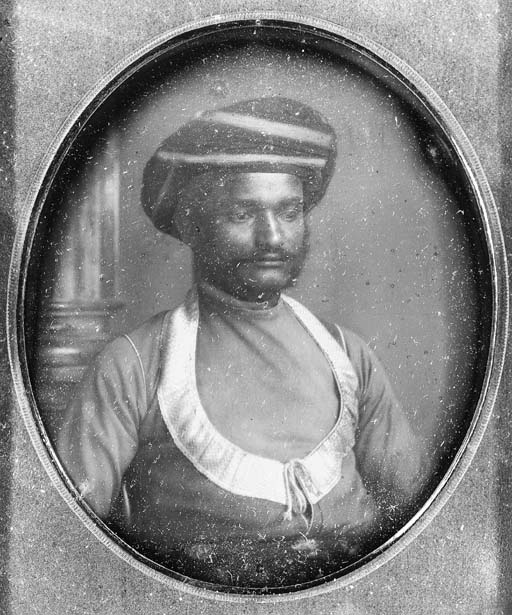
Daguerreotype
John William Newland, Portrait of an Indian Army Officer, Calcutta, 1850s
Announced in Paris in 1839, the daguerreotype was the first publicly
available photographic process. The daguerreotype image was created on a
silvered metal plate exposed to iodine fumes, forming a light-sensitive
surface of silver iodide. Development was achieved by exposing the
plate to fumes of heated mercury and the image fixed in a salt solution.
The daguerreotype produced an image of remarkable sharpness, but unlike
competing processes, each daguerreotype was unique. This proved to be
the major factor in its demise, compared to the negative-positive
processes, from which unlimited copies could be made. J. W. Newland, the
photographer of this portrait, had practised as a daguerreotypist in
North and South America, the Pacific and Australia, before establishing a
studio in Calcutta in about 1850. Although his studio remained
successful throughout the 1850s, Newland himself died in 1857, one of
the early victims of the Indian Mutiny.
Source : British Library
John William Newland

John William Newland (?–1857) an English daguerreotypist hailed from Redgrave in Suffolk, England. He was titled as a traveling daguerreian photographer who spanned the continents. He started his travels from New Orleans in 1845, traversed via Panama and Jamaica to reach Lima, Peru in December 1846. In early 1847 in was in Callao and by mid of the year he was in Valparaiso following which he traveled on to Fiji and Auckland, New Zealand, Australia and finally to Kolkata, then Calcutta, India.
He opened the professional daguerreian studio in Loudon’s Buildings in Kolkata, India, taking in F. W. Baker as his assistant where he made the earliest known Indian daguerreotypes.
The daguerreotype was the first commercially successful photographic process in the history of photography. Named after the inventor, Louis Jacques Mandé Daguerre, each daguerreotype is a unique image on a silvered copper plate.
The daguerreotype image was created on a silvered metal plate exposed to iodine fumes, forming a light-sensitive surface of silver iodide. Development was achieved by exposing the plate to fumes of heated mercury and the image fixed in a salt solution. The process is accurate, detailed and remarkably sharp, and each daguerreotype is unique. It has a mirror-like surface and is very fragile. Since the metal plate is extremely vulnerable, most daguerreotypes are presented in a special housing.
John William Newland’s daguerreotype identified by either a blind stamp on the gilt matt, or with the photographer’s studio stamp ‘No 6 Loudon’s Buildings, Newlands Daguerreotype, Kolkata, inside the cover of the case. Daguerreotypes were very expensive, so only the wealthy could afford to have their portraits taken. John William Newland made 1/4 plate daguerreotype of Royals and Military personalities in Kolkata.

By 1857 John William Newland had expanded into positives on paper and glass and he offered stereoviews of Kolkata and its vicinity. He took in his half-brother Frederick Welling as an assistant and the daguerreotype and photographic business in Loudon’s Buildings, Kolkata survived until about 1860. John William Newland claimed to have made over 200 daguerreotypes on the way from New Orleans to Kolkata.
In 1957, John William Newland was brutally murdered by the Sepoy Mutiny Soldiers, when he was travelling with another unknown photographer to document the Sepoy Mutiny from Meerut and Delhi. He was taken from the dak carriages and mutilated with great barbarity and considered to be one of the early victims of the Indian Sepoy Mutiny.

John William Newland exhibited his daguerreotypes wildly and the collections are now found in Tasmanian Museum and Art Gallery in Hobart, Mitchell Library, State Library of New South Wales in Sydney, and in Historic Photograph Collection, Macleay Museum, University of Sydney in Sydney.
Reference
https://alphonsegallery.zenfolio.com/newland
http://www.luminous-lint.com/app/photographer/J_W__Newland/C/
https://trove.nla.gov.au/people/1485573?c=people
https://britishphotohistory.ning.com/
https://www.rarebooksocietyofindia.org/
http://www.daguerreobase.org/
Encyclopedia of nineteenth-century photography / John Hannavy


No comments:
Post a Comment